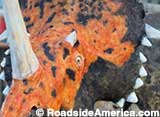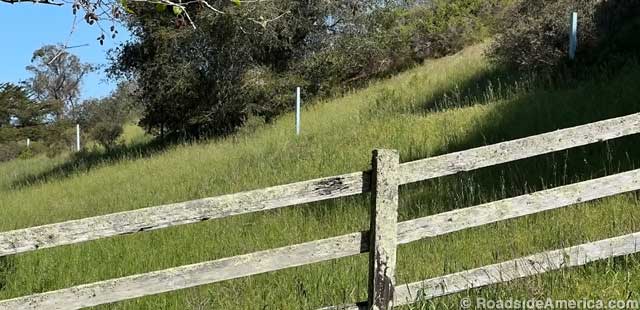
Blue posts mark the current active fault.
1906 Earthquake Trail
Point Reyes Station, California
"Plate tectonics is happening beneath you," advises an interpretive panel in a wooded meadow. While you may not think much about the movement of the Earth's crust, on the Earthquake Trail it's hard to ignore the slippy-slide serendipity of Mother Nature.
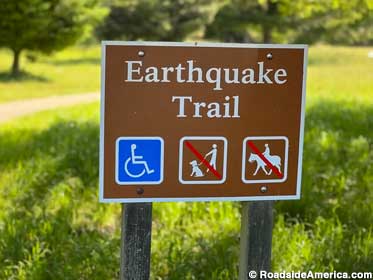
Earthquake Trail is wheelchair accessible.
Plates underground grind against one another relentlessly, pushing up, down, sideways, squeezing out magma and forming subduction ridges. For over a century, the Great San Francisco Earthquake has been America's premiere seismic disaster darling. The Earthquake Trail preserves a glimpse of its impact.
On April 18, 1906, a magnitude 7.8 earthquake struck along the San Andreas Fault at 5:13 am. It lasted 45 seconds. San Francisco suffered horrific damage -- most of what didn't tumble down was lost in an incendiary aftermath that destroyed 500 city blocks. The survivors dusted themselves off and rebuilt a metropolis, hub of the techno future (with all its modern woes and distractions). Life goes on. Still, we need public reminders that the planet's next big plate trick is inevitable, and coming soon.
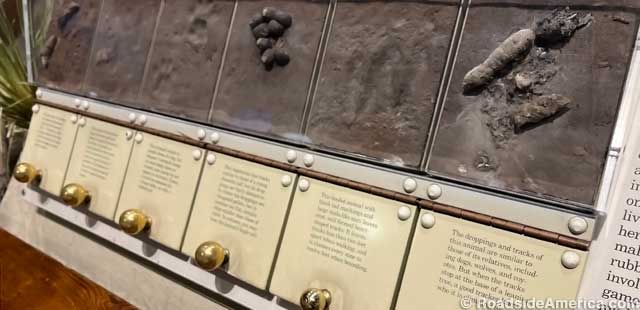
Spoor doors challenge the scat tracking skills of visitors.
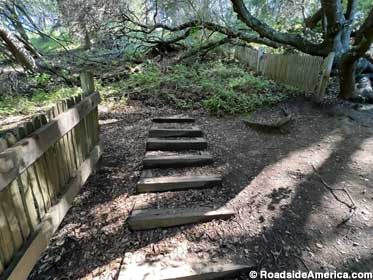
Fence shows 16 ft. gap from the 1906 fault slip.
The Bear Vallley Visitor Center, headquarters for the Point Reyes National Seashore, features several displays teaching about the San Andreas Fault, The Center covers the whole peninsula's topography, wildlife and environmental challenges. There's an elephant seal statue, local wildlife taxidermy, plant info. A Spoor Doors display invites visitors to identify wildlife droppings and tracks. We imagine that a sudden earthquake triggers a fresh profusion of wildlife scat.
For years, the Center featured an operating seismograph, with paper drum and quivering graphing needle. That lingers only as a glassed-in artifact (a non-public sensor still monitors the area). The larger context of earthquakes is illustrated by a topographic map -- the San Andreas Fault runs northwest to southeast along the length of Tomales Bay, separating Point Reyes from the mainland.

"Rocky, wake up, there was an earthquake. Rocky? ROCKY!!!!"
The 1906 quake epicenter was in the Pacific Ocean, south of the Golden Gate, causing the two fault plates in Olema to slip dramatically.
The Earthquake Trail starts across from the visitor center parking lot, near the picnic tables. The .7 mile paved pathway is a loop, passing through meadows and woodlands. Interpretive signs along the way explain the many aspects of the earthquake and plate tectonics. The panels (in need of a good cleaning or replacement) are factual, not sensational, though they strive to engage the reader: Some Coast Miwok Indians credit the shakes to a fidgety giant sleeping face-down under the earth (there's a recreated Coast Miwok village, Kule Loklo, on a trail north of the Visitor Center). Another panel asks "Are you at risk?" and hikers enjoying fresh air and pastoral views likely think "No."
That sign would be more alarming to see in a downtown elevator.
Back on the Earthquake Trail, a companion series of panels, "For Kids," rewards youngsters with fun factoids: "The 5:15 am train to San Francisco from Point Reyes Station first swayed to the east, then to the west, and then fell off the tracks!"
The Trail's most dramatic evidence from 1906 is a preserved wooden fence, split by 16 feet as the ground slid. Visitors marvel at the gap. Nearby, blue posts spaced down to a barn mark the "active fault trace."
In more recent memory, the SF Bay Area was roiled catastrophically on October 17, 1989 by a 6.9 magnitude earthquake. The epicenter area in the Santa Cruz Mountains near Aptos is noted by a historical marker.




